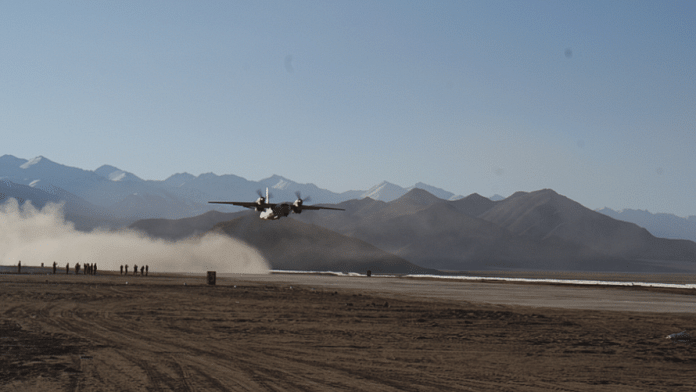New Delhi: The Ministry of Defence this week initiated work on expanding the Nyoma Advanced Landing Ground (ALG) in eastern Ladakh into a full-fledged operating base from where fighter aircraft can take off, ThePrint has learnt.
Sources in the defence and security establishment told ThePrint that the work, which entails a concrete runway of 2.7 km along with allied infrastructure, will be completed in less than 20 months. It is learnt that Defence Minister Rajnath Singh is likely to visit the area to inspect the ongoing work next month.
The sources also said that, since this will be the world’s highest airfield — Nyoma is at 13,700 ft — the fighter engines are being tweaked to enable them to operate from such heights.
Currently, the Nyoma is an ALG, which means that the runway is actually made of mud that allows only specialised transport aircraft like the C-130J and helicopters to land. Once the new runway is complete, heavier transport aircraft will also be able to operate from Nyoma, which will add to the strategic depth of the Indian military.
The Nyoma ALG played a crucial role in the ongoing stand-off with China as the C130Js helped in quickly inducting men, heavy weapons and equipment at the Line of Actual Control (LAC) when tensions began in 2020.
The move by India comes at a time when China has already completed upgrading all its bases along the LAC with longer runways, and hardened shelters, among others. It has also created new heliports, including one in Tianshuihai, which is near the Galwan Valley and the Aksai Chin region, and the other in Rutog County — which is near the northern bank of Pangong Tso, as reported by ThePrint earlier.
Sources said that India’s aim is to put in a full-fledged and defensive capability and deployment to counter China’s strategy of “Anti Access Area Denial (A2AD)”. This strategy by China involves restricting the enemy’s freedom of movement on the battlefield through the deployment of a wide range of surface-to-air missile (SAM) sites and long-range radars, apart from a large number of soldiers, artillery, rocket forces and armoured elements.
Sources said the fighter operations from Leh, Nyoma, Thoise and Srinagar will help the IAF in carrying out faster flights in case of any emergency, but in an actual conflict, it will be the bases in the hinterland, especially Punjab, that will fight it. This is an advantage to India when it comes to fighter jet operations, they added.
Also Read: ‘Incorrect assessment’ led to delays in development of HAL’s intermediate jet trainer, says CAG
Idea behind expansion of ALG
According to sources, a need was felt to have an alternate operating base for fighters in Ladakh, besides the one at Leh and Thoise. This was because weather conditions affected the operational capability of these two bases.
A study was undertaken by the Indian Air Force (IAF) to understand which of the three ALGs in Ladakh — Daulat Beg Oldie (DBO), Nyoma and Fukche — could be used for fighter operations.
Two facts went against DBO. First, it was the height at which it stood (16,600 ft), and second, it is within the visual circumference of the Chinese, sources explained.
They said that the ability to expand the runway and creation of additional infrastructure was limited in Fukche and, hence, scales tilted in favour of Nyoma. Another factor that worked in favour was the weather at Nyoma, which remains mostly operational throughout the year.
However, a problem relating to environmental clearances existed since there was also the Changthang Wildlife Sanctuary — home to Kiang or the Tibetan Wild Ass and rare black-necked crane. Sources said the IAF had reworked the expansion plans to get the environmental clearances, which has come through with certain riders.
(Edited by Richa Mishra)



